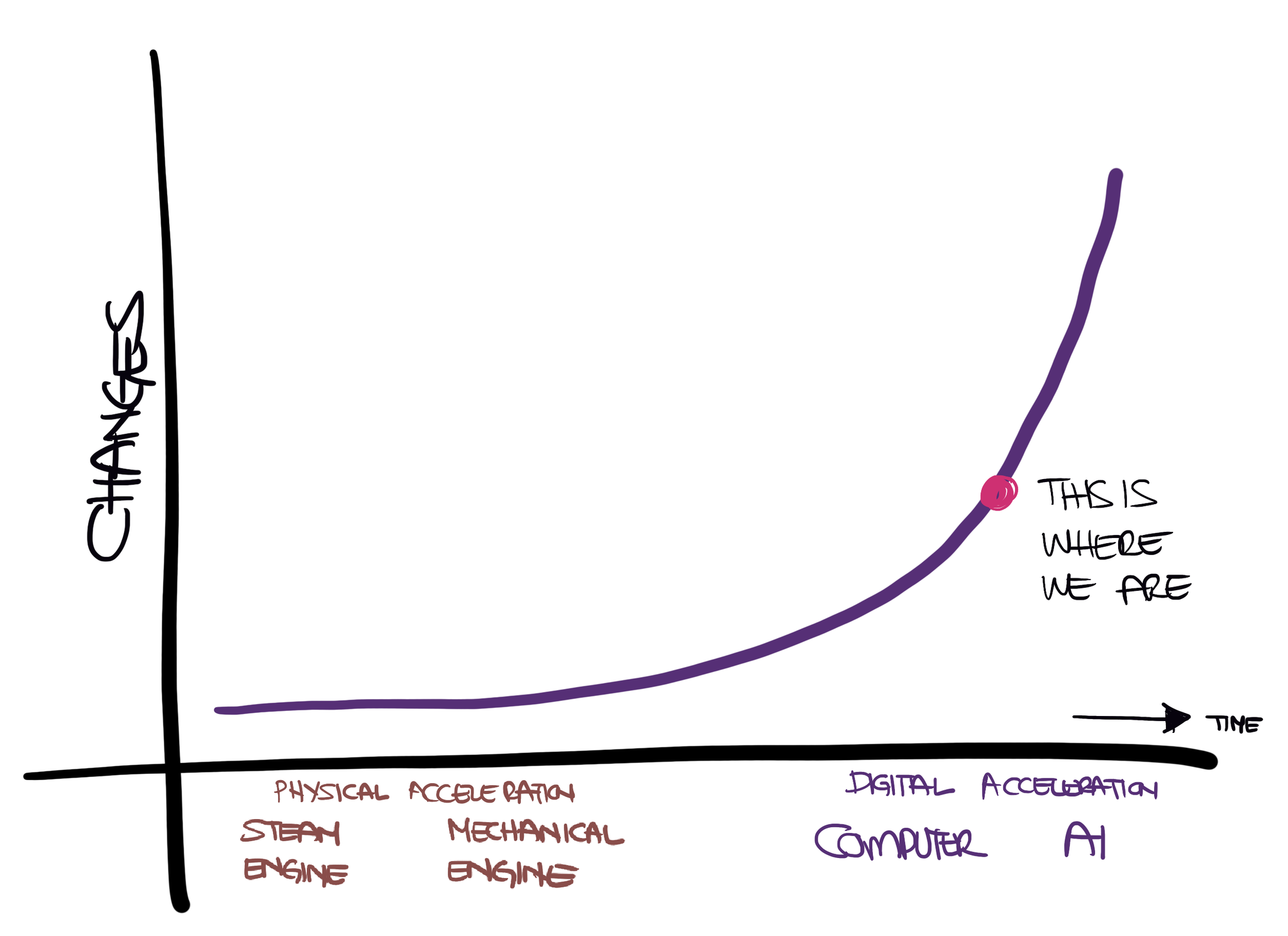Let’s face it : Humans are not the fastest nor the strongest species on the earth. Cheetahs are the fastest and whales are the largest. So how did we end up dominating the planet ?
Beyond our physical attributes, the real superpower of mankind is derived from the ability to adapt and learn from our own mistakes. Over time, our knowledge and wisdom grow through past errors and years of learning. Interestingly, mankind also knew how to pass on the information as lessons to the next generations. It’s only natural that humans are able to evolve and become the most dominant species on earth.

Another interesting fact is that relative to body size, our brain is larger than typical mammals. According to studies, the environmental factors which involved adaptations and information transmits could be the reasons why it expanded. However you’d be surprised to learn that brains are actually not designed to do those tasks all the time. In fact, brains are designed as a part of survival system and body regulating organ - that’s it.
Compared to our ancestors who mainly used the brain during hunting time - with lots of rest time in between too-, it’s safe to say that human brains are only getting more and more worked up. As we are moving rapidly into the information age, we have to make decisions or solve problems by the seconds. Rapid changes are inevitable, leaving us restless and getting more and more indecisive.
This is when “Decision Burnout” kicks in, a kind of fatigue and weary feeling when you are overwhelmed with information to choose from. The more decisions you make, you may feel worse and drained as the day progresses. If you are feeling that, it could be a sign of Decision Burnout.
So, How Did We Get Here?
In his book ”, Thomas Friedman coined the term “Accelerated Age”. It is defined as : the rate of change (fueled by technology) that is now going faster and faster. So fast is the process that it will soon exceed our human capability to learn.
To explain how we got to Decision Burnout, it’s important to understand the timeline of Acceleration Age as explained below:

1. Physical Acceleration
To keep up with economics demands, humans have been searching for ways to cut time in the name of efficiency. This is when Physical Acceleration was introduced to allow humans to work faster in production. The two dominant examples in this phase are:
Machine ( from 1450 to 1840), for example: machine used in the textiles industry and the trend of machines replacing many
Invention of Steam Power( from 1770 - 1920), where we saw the replacement of horse-pulled transportation with steam engines for faster material movements.
2. Digital Acceleration
Next comes the era of Digital Acceleration. Similar to physical acceleration, but with no real tangible products, the product in focus is information. Humans are motivated to find ways to move data, content and other forms of information as fast as possible. This type of acceleration sees the birth of mobile phone and Artificial Intelligence that we know today.
How to Handle “ Decision Burnout”?
While it is impossible to slow down the rate of changes be it physically or digitally, we can still come up with strategy and ideas to help reduce the decision fatigue. Here are couple ideas that I have learned over time that not only help avoid decision burnout but also improve my quality of decision-making.
1. Unclutter your life
We tend to accumulate things, beliefs and experiences. The piles weigh us down physically and mentally, to a point that we are an accumulation of everything around us. I learned that it’s crucial to always dispose and declutter certain aspects of my life. A few notes that really helped me in this area are:
Reading and practicing “The Life-Changing Magic of Tidying Up: The Japanese Art of Decluttering and Organizing” by Marie Kondo.
The knowledge that our past will become a weight that holds us back and keeps us from living in the present. To put things in order is to put your past in order too, to reset and settle all accounts that prohibit you from taking the next step forward.
A regular self-cleanse and updates based on the roles I’ve assumed, be it as a professional, a spouse, a father, a friend and all.
An annual clean up is a must

2. Prioritize your attention
We are not born multitaskers, yet many of us have laser-sharp focus and I truly admire people who can function at different tasks at the same time. But that’s also where Decision Burnout creeps in, so my tips are :
To filter decisions and sort them into “Low Impact” and “High Impact”.This way I can focus on one thing at a time, allowing faster problem solving and better quality results. When I’m not as burnout, I also tend to be faster with my lower priorities and with better outcomes too.
Apply Rules of Disengagement.This is when I completely detach during breaks or family time, putting my worries or deadlines aside instead of always engaging with them.
Set a maximum decision per day.This may vary on different days. On busy days, my decision slots may be higher than during weekends. But the main rule is once the quota is exceeded, I bench it until the next day.
Use certain cues for rest.For example, I know that as the sun sets and the sky turns darker blue, it’s a signal for me to turn off any digital tool - no exception.
3. Knowing how to work with incomplete information.
I’m sure many of us have to make decisions even when we don’t have the complete pieces of puzzle to solve the issues. This is inevitable, but there are ways to tackle incomplete information for better decision-making.
These are the things I learned from “Making Smarter Decisions When You Don't Have All the Facts” by Annie Duke :
Write all information available down.
Break it up by 3 categories : Consideration -> Option -> Outcome
Convert the probability into percentage
Calculate the risk
This may sound complex, so I hope to cover this at length in the next future post. Please look forward to it.
4. Plan your reset
When’s the last time you really reset? I mean, really really turn off all distractions and engage with your inner self. With the pandemic, the lines between work and leisure have really blurred but it’s important to actually plan your rest. Here’s how I do it.
Schedule downtime regularly, which I use for my daily/weekly meditation. I also plan a longer break to travel and reset my energy.
Set aside my alone time to reflect from my mistakes but also revel in my victories.
5. Focus only on decision-making process and not the outcome
Like in growth mindset, it’s important to focus on process and not the outcome. When you put a pause on what the final results may be, you’re able to entirely focus on the actions toward your goals.
Easier said than done, but keep these few things in mind with you:
When there’s good outcomes, we tend to take credits and believe that we’ve made good decisions. In reality, it could be a matter of luck, timing and other factors.
Make an effort to shift your efforts on expecting good results, but rather, dedicate your time and energy to the process of decision making.
Use the best information at that time and follow a strategy of good decision-making. Again, forget the outcome.
Don’t equate the quality of the outcome too with the quality of decisions. Why? You are in charge of the decision you make, it’s within your control. However, no one can 100% predict an outcome right?
Key Takeaways
Decision Burnout is just as serious as it sounds, you are driving yourself to a point of exhaustion due to too many decision making. It is real and happens to even the best of us. I can only urge you to not ignore it since the toll on your physical and mental health can be immense.
Life can throw you endless decisions, learn how to sort them to your best ability and do your best. As you will learn, strategies exist and can be implemented to benefit you. I hope that what I outlined in this post can somewhat give you an idea on how to apply them to your personal situation.
Lastly, let’s remember to get in touch with our human side. Work hard, but play too. Life is a process, might as well enjoy it!